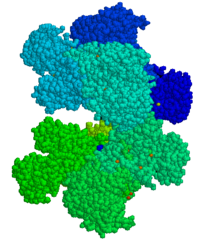
Photo from wikipedia
To the Editor, Drug-induced immune hemolytic anaemia (DIIHA) is rare, with severe hemolysis occurring in approximately 1 in 1 000 000 patients. More than 115 medications have been implicated in… Click to show full abstract
To the Editor, Drug-induced immune hemolytic anaemia (DIIHA) is rare, with severe hemolysis occurring in approximately 1 in 1 000 000 patients. More than 115 medications have been implicated in precipitating hemolytic anaemia; however, many cases are circumstantial, with the onset of hemolysis coinciding with drug administration and resolution following discontinuation of the drug. Reasonable certainty of drugdependent DIIHA requires serologic analysis. This phenomenon is commonly associated with a positive direct antiglobulin test (DAT) for IgG, negative elution studies, and identification of an antibody in the patient's serum that is capable of binding reagent red blood cells (RBCs) only in the presence of the drug. DIIHA is underrecognized, as cases may be confused with warm or cold autoimmune hemolytic anaemia (AIHA) or hemolytic transfusion reactions when the drugdependent antibody is reactive in routine antibody detection. Additionally, as not all testing methodologies are widely available, the true incidence of DIIHA, patient risk factors for developing DIIHA, and the identities of all precipitating drugs remain unknown. Antimicrobials represent one of the most common drug classes associated with DIIHA, of which cefotetan and ceftriaxone, 2ndand 3rd-generation cephalosporins, respectively, are most frequently implicated. Despite these well-documented associations, no cases of DIIHA attributed to cefepime, a commonly used 4th-generation cephalosporin, have been reported to date. The US Food and Drug Administration (FDA) package insert for cefepime states a positive DAT occurred in 16.2% of clinical trial patients, but no cases of hemolysis were reported. Herein, we describe a novel case of cefepime-induced immune hemolytic anaemia with identification of a cefepime-dependent antibody. A 74-year-old woman with a history of chronic back pain statuspost laminectomy 10 years prior was admitted for altered mental status (AMS) and fever. On admission, she was hypotensive and diaphoretic, with concern for septic shock. She was treated empirically with cefepime 2 g IV every 8 h and vancomycin 1 g IV every 12 h. Imaging was concerning for T12-L1 discitis-osteomyelitis. She remained hospitalised for 5 days and was discharged on cefepime 6 g IV every 24 h by continuous infusion and vancomycin 1 g IV every 12 h. Eleven days later, she was re-admitted with AMS and dyspnea, and had reportedly become progressively lethargic, confused, and weak since hospital discharge. Exam demonstrated normotension, tachycardia, and tachypnea. Laboratory evaluation was significant for anaemia with a haemoglobin of 7.5 g/dl, despite a known baseline of approximately 12.5 g/dl (reference: 11.8–16.0 g/dl) (Figure 1). Cefepime was discontinued and piperacillin-tazobactam was initiated due to concern for cefepime-induced encephalopathy. She received a total of three doses of piperacillin-tazobactam 3.37 g IV over a period of 18 h. Laboratory evaluation 12 h following admission was significant for a haemoglobin of 5.9 g/dl (Figure 1), elevated lactate dehydrogenase (LDH) of 946 U/L (reference: 125–220 U/L) and total bilirubin of 1.6 mg/dl (reference: 0.2–1.2 mg/dl), and undetectable haptoglobin <8 mg/dl (reference: 40–273 mg/dl). Blood bank evaluation demonstrated a negative antibody detection test, positive auto-control, positive DAT for IgG (3+ reactivity) and C3 (1+ reactivity), and negative elution studies via standard tube methods. The laboratory findings were suspicious for hemolytic anaemia, and the positive DAT and non-reactive eluate prompted further evaluation for a potential drug-mediated cause. Agglutination (weak reactivity) occurred when the patient's serum was tested against ficin-treated and untreated type O reagent RBCs in the indirect antiglobulin test (IAT). This weak reactivity was presumably due to the presence of circulating cefepime at the time the blood sample was drawn. Patient serum did not agglutinate type O reagent RBCs in the IAT using polyethylene glycol (PEG) enhancement. In the presence of cefepime, patient serum agglutinated type O reagent RBCs at the immediate spin (IS) phase (2+ reactivity), 30 C (micro-agglutination), and the IAT (weak reactivity) without the use of potentiating agents. Testing was repeated using a second type O reagent RBC with patient serum and cefepime, with agglutination at IS (2 + reactivity), 30 C (2+ reactivity), and at IAT (2+ reactivity) without the use of potentiating agents. A phosphate buffered saline negative control was nonreactive. The patient received one dose of oral prednisone (1 mg/kg), as the clinical haematology service suspected warm AIHA, and piperacillintazobactam was discontinued. Following the results of DIIHA testing, cefepime was entered as an allergy in the clinical record with a notation that it may potentially cause hemolysis. At the time of this report, she remained hospitalised, and had required transfusion of three units of red blood cells over 4 days following discontinuation of the cefepime. Her hemolysis labs began to slowly improve, and her haemoglobin began to stabilise. This clinical scenario highlights to our knowledge the first reported case of cefepime-induced immune hemolytic anaemia. Our suspicion for cefepime-induced hemolysis was high given the temporal relationship of cefepime administration with the clinical symptoms and laboratory values. While we acknowledge that piperacillin is a common cause of DIIHA, we did not test for a piperacillin-dependent antibody given the onset of her anaemia and symptoms prior to the Received: 16 July 2021 Revised: 8 September 2021 Accepted: 10 October 2021
Journal Title: Transfusion Medicine
Year Published: 2021
Link to full text (if available)
Share on Social Media: Sign Up to like & get
recommendations!